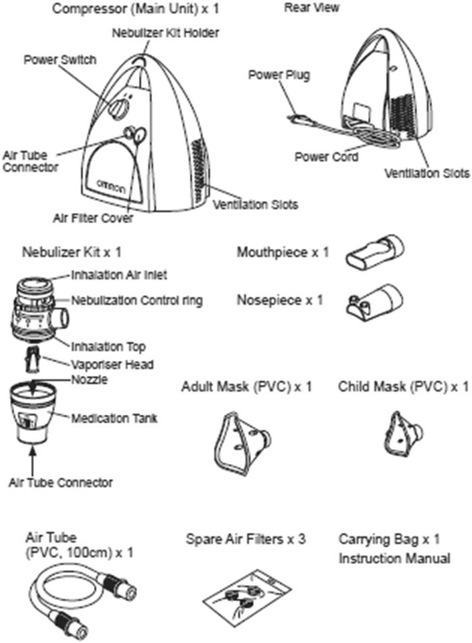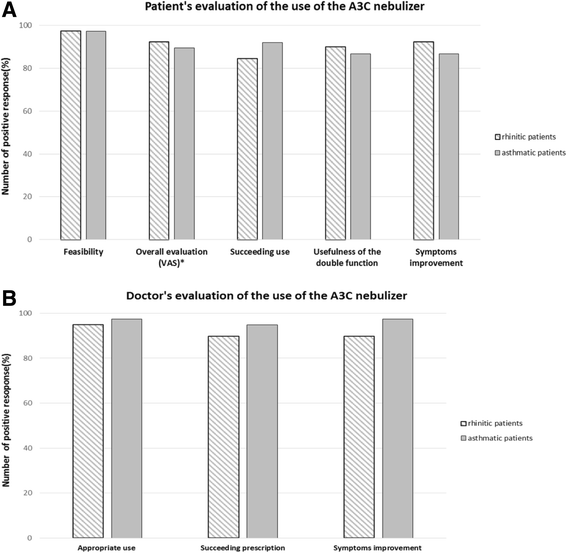Efficacy and usability of a novel nebulizer targeting both upper and lower airways
- PMID: 28962626
- PMCID: PMC5622502
- DOI: 10.1186/s13052-017-0400-x
Efficacy and usability of a novel nebulizer targeting both upper and lower airways
Abstract
Background: Upper and lower airways diseases share in part their pathogenic mechanisms and frequently occur simultaneously as "United Airway Disease." Local treatment with nebulizers delivers anti-symptomatic drugs in either the upper or the lower airways, according to the particle size generated by the nebulizer. To our knowledge, no nebulizer combines both application ways. The aim of this study is to test the efficacy and usability of a new nebulizer (OMRON A3 complete), generating aerosols with particles diameters of 2-4.5 μm, 4.5-7.5 μm or >7.5 μm, according to the user's choice.
Methods: Seventy-seven patients between 5 and 17 years of age with a diagnosis of rhinitis or asthma were examined. Oxymetazoline or Salbutamol were prescribed according to best clinical practice guidelines. Both drugs were administered through the OMRON A3 Complete nebulizer, with a particle dimension of >7.5 μm to treat nasal obstruction and 2-4.5 μm for bronchial obstruction. The efficacy of treatment was assessed by total nasal inspiratory airflow and FEV-1, Tiffeneau index (FEV1/FVC) and MMEF 25/75 respectively, 10 min before and after treatment. Symptom improvement and usability were measured by patients' and doctors' questionnaires.
Results: Overall, 77 patients seeking care for acute respiratory symptoms were assigned to the upper (n = 39) or lower (n = 38) airways disease group. For symptoms of the upper airways, 92% (95% CI, 77-97%) of the patients reported subjective improvement, while 87% (95% CI, 73-94%) did so for the lower airways. The average total nasal inspiratory airflow improved significantly (p = 0.030) among the patients with upper airways symptoms, from 275 ml/s (95% CI, 207-342 ml/s) to 359 ml/s (95% CI, 300-419 ml/s) after Oxymetazoline administration. All selected lung function parameters (FEV1, Tiffeneau Index and MMEF25-75) significantly improved among the patients with lower airways symptoms after inhalation of Salbutamol (p < 0.001). The nebulizer was assessed as "easy to use" by over 95% of participants in both groups.
Conclusions: The OMRON A3 efficiently delivers anti-symptomatic drugs in both upper and lower airways in a user-friendly way. This device may be useful to facilitate adherence to a complete treatment of respiratory symptoms in patients with symptoms of the so-called United Airway Disease.
Keywords: Asthma; Children; Nebulizer; Oxymetazoline; Rhinitis; Salbutamol.
Conflict of interest statement
Ethics approval and consent to participate
The study was approved by the Charité Ethic Committee. The informed consent was obtained from participants and their parents after full explanation of the purpose and nature of all procedures used.
Consent for publication
The patients and their parents released their consent for the publication of their data in an anonymous form.
Competing interests
SL receives grant support from German Ministry of Agriculture and Nutrition, Symbiopharm and Merck and personal fees from Merck. PMM serves as a consultant for Thermo Fisher Scientific, HYCOR biomedical, and Euroimmun AG, receives grant support from Thermo Fisher Scientific, and receives lecture fees from OMRON. The other authors declare that they have no relevant conflicts of interests.
Publisher’s Note
Springer Nature remains neutral with regard to jurisdictional claims in published maps and institutional affiliations.
Figures



References
-
- Ellwood P, Asher MI, Billo NE, Bissell K, Chiang CY, Ellwood EM, et al. The Global Asthma Network rationale and methods for Phase I global surveillance: prevalence, severity, management and risk factors. Eur Respir J. 2017;49(1). - PubMed
-
- Roberts G, Xatzipsalti M, Borrego LM, Custovic A, Halken S, Hellings PW, et al. Paediatric rhinitis: position paper of the European Academy of Allergy and Clinical Immunology. Allergy. 2013;68(9):1102–1116. - PubMed
-
- Passalacqua G, Ciprandi G, Canonica GW. The nose-lung interaction in allergic rhinitis and asthma: united airways disease. Curr Opin Allergy Clin Immunol. 2001;1(1):7–13. - PubMed
Publication types
MeSH terms
Substances
LinkOut - more resources
Full Text Sources
Other Literature Sources
Medical

